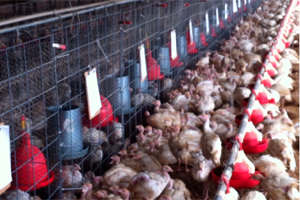Turkey feed trial helps reduce Salmonella species

Food safety is a critical topic for poultry producers and consumers. A trial by animal nutritional company, Diamond V has demonstrated significant reductions in Salmonella species by using their product Original XPC.
Initial studies were conducted in-vitro (using a lab model that mimics the poultry digestive tract). Then results were further validated with in-vivo (live bird) trials, and finally with environmental (house swab) monitoring. Research studies have been reported showing reductions in the prevalence (number of positives) and load (colony forming units per gram) of S. typhimurium, enteritidis, arizonae, kentucky and heidelburg.
With a large set of data from laying hens, eggs and facilities, it was of interest to determine if commercial meat birds might demonstrate similar reductions in Salmonella when birds were fed Original XPC in the diet. Therefore, a simple screening trial was conducted with brooding turkeys (0 to 5 wks) to indicate if Original XPC might be efficacious against Salmonella in the turkey barn.
Turkey hen poults were sourced from a known Salmonella positive US breeder flock. On the day of hatch (0d), poults were transported to a commercial brooding facility where birds were confined with brooder rings for the first 7 days. Birds in half the rings received a standard commercial starter feed (Control) and the
remaining rings were provided the same starter diet, with the addition of 2.5 lb/ton Original XPC (XPC). The test diet was blended with the test article at the University of Arkansas research feed mill.
At 7d, birds of each treatment were weighed and assigned to one of 30 pens for the remainder of the brooding period (7 to 37d). Pens were assembled in a row down the center of the brooding barn. Pens were constructed of welded wire and poultry wire such that each secure pen measured 16 sq. ft., with 1 bell drinker and 1 hanging feeder per pen of 23 hens. Treatments were alternated in this design with Control birds in 15 odd-numbered pens and XPC hens in 15 even-numbered pens.
When hens were allocated to pens at 7d, 20 control birds were submitted to an independent laboratory for Salmonella determination. Of these 20 birds, Salmonella was cultured from 15 (75%), confirming that test birds had been exposed to Salmonella.
Prior to moving from the brooding to growout facility at 37d, all birds and remaining feed in each pen were weighed and 6 birds per pen (90 per treatment) were necropsied. The ceca from each bird sampled was removed and delivered to an independent lab for Salmonella testing.
Salmonella positive birds were observed in 3 of the 15 Control pens (20%). No incidence of Salmonella (0%) was identified from XPC birds in adjacent pens. Due to the low recovery of Salmonella in test pens, Fisher’s exact test was used to test for statistical difference between treatments (P = 0.11). No statistical differences were observed for growth rate, feed conversion or mortality between 7 and 37d. Only 2 pens lost 1 bird each during this period.
Results of this research suggest that adding Original XPC to the starter feed (2.5 lb/ton) of turkeys can help reduce the incidence of Salmonella colonisation under naturally challenged conditions.











